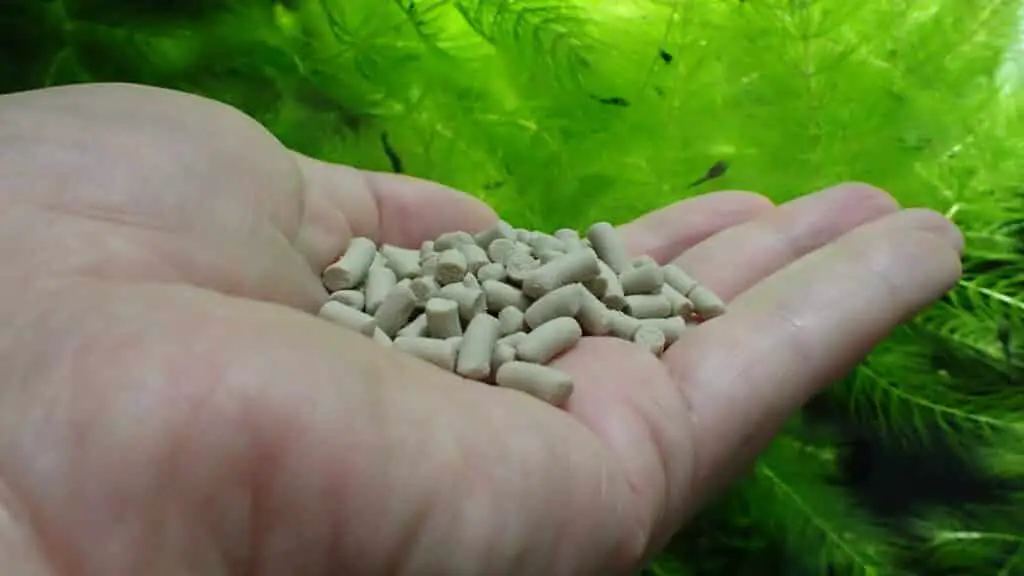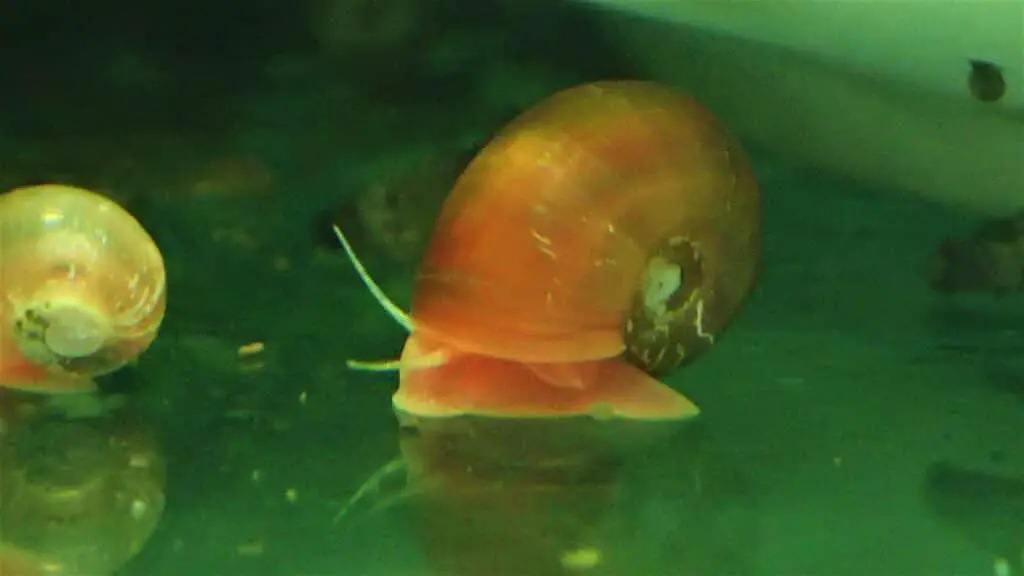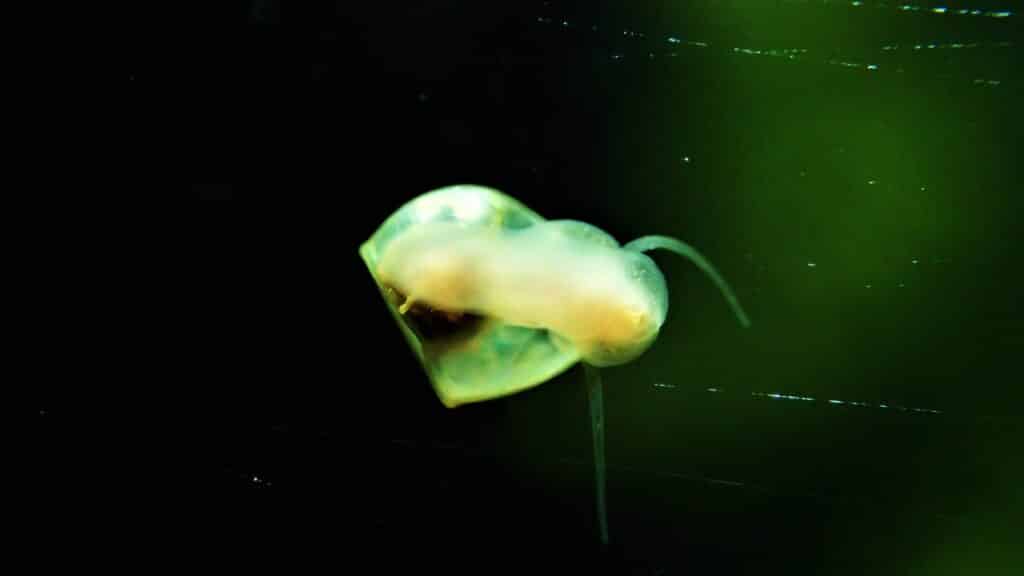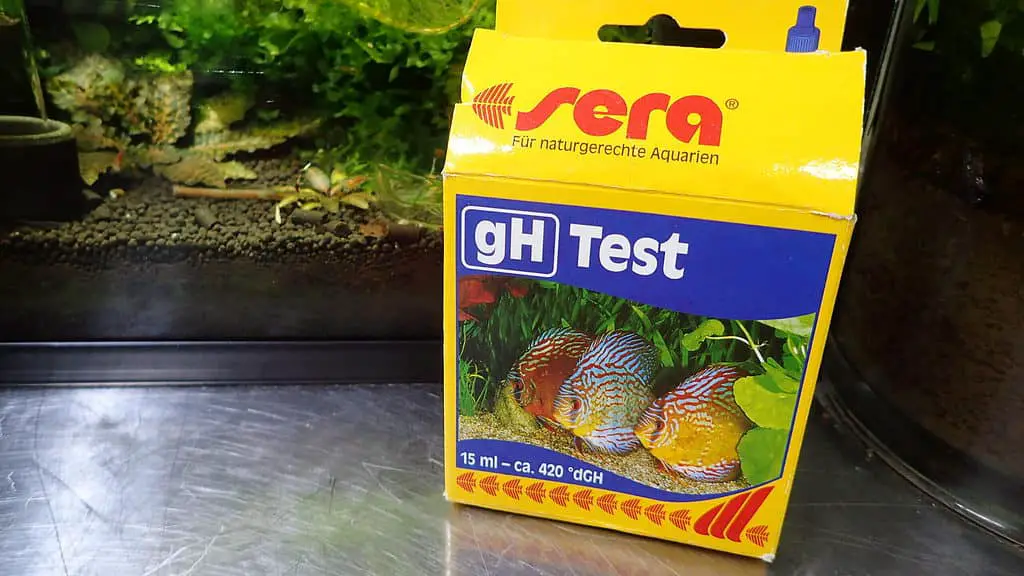To breed Ramshorn Snails, set up a tank with optimal water conditions and a balanced diet. Gently introduce a group of healthy snails and provide hiding spots like plants or decorations. The snails will mate and lay eggs on surfaces, which will hatch into baby snails within a few weeks.
Common names: Ramshorn Snail, Planorbidae
| Parameter | Details |
|---|---|
| Tank size | 5+ gallons |
| Temperature | 70-78°F (21-25°C) |
| pH | 7.0-7.5 |
| General Hrdness | over 6 |
| Diet | Algae, detritus, vegetables, fish food |
| Breeding rate | High; multiple egg clusters per week |
| Egg hatching time | 2-3 weeks |
| Sexual maturity | 2-3 months |
Understanding the Ramshorn Lifecycle
Ramshorn snails are a popular addition to many aquariums due to their ability to help maintain a clean environment by eating algae, leftover food, and detritus. Breeding Ramshorn snails can be both an interesting hobby and a practical way to control their population in your tank. This guide will help you understand the intricacies of the Ramshorn snail lifecycle and how to breed them successfully.
Ramshorn snails are hermaphrodites, meaning each snail possesses both male and female reproductive organs. This unique characteristic allows them to mate with any other Ramshorn snail in the aquarium. Mating typically occurs when the snails are healthy, have a balanced diet, and when water conditions are favorable. Optimal water conditions include a pH level of 7.0-7.5, temperature between 70-78°F (21-25°C).
In a well-maintained aquarium, Ramshorn snails will find plenty of natural food sources, such as algae and detritus. However, you can supplement their diet with vegetables, shrimp pellets, or high-quality fish food to ensure they receive all the nutrients they need. Providing a healthy diet will encourage successful reproduction.
Once the Ramshorn snails mate, they will lay small clusters of eggs on surfaces like aquarium glass, decorations, or plants. The eggs are enclosed in a transparent, gelatinous mass. It is important to keep an eye on these snail eggs, as they will hatch within 2-3 weeks under the right conditions.
As the baby Ramshorns snails emerge, they will immediately begin to feed on algae and other food sources. They will grow rapidly, reaching sexual maturity in 2-3 months. When breeding Ramshorn snails, it’s essential to maintain a clean tank with stable water conditions, as this will support their health and encourage reproduction.
Ramshorn snails can coexist with a variety of tank mates, including small, non-aggressive freshwater fish, shrimp, and other snail species. It’s essential to avoid adding aggressive fish or goldfish to your tank, as they may eat or damage the snails.
By understanding the Ramshorn snail lifecycle and providing the proper care, you can successfully breed these fascinating creatures while also maintaining a healthy, balanced aquarium ecosystem.

How to Set Up a Tank to Breed Ramshorn Snails
Creating the ideal environment for Ramshorn snails breeding is key to their successful reproduction. This comprehensive guide will help you set up a tank that encourages Ramshorn snails to breed and supports their overall health.
First, select an appropriate tank size for your Ramshorn snails. A 5-gallon tank is suitable for a small group of snails, but a larger tank may be necessary if you plan to house more snails or other tank mates. Keep in mind that a larger tank will provide more surface area for the snails to lay their eggs and offer more hiding spots for the baby snails.
Next, consider the substrate for your aquarium. Ramshorns snails are not picky about the substrate, but a fine sand or small gravel will work well. This type of substrate will not damage their soft bodies or delicate shells as they move around the tank.
Water conditions are crucial for breeding Ramshorn snails, so ensure the tank’s temperature is maintained between 70-78°F (21-25°C), the pH level is between 7.0-7.5, and water hardness is 5-15 dKH. Regular water changes and the use of a high-quality filter will help maintain stable water conditions, promoting healthy snails and successful reproduction.
Adding live plants to the tank will not only make the aquarium more aesthetically pleasing but also provide hiding spots and additional food sources for the snails. Plants like Java Moss, Anubias, and Java Fern are excellent choices, as they are hardy and can tolerate various water conditions. Moreover, these plants will help improve water quality by absorbing excess nutrients.
When introducing Ramshorn snails to the tank, ensure they are healthy and free from diseases or parasites. Quarantine any new snails before adding them to your main tank, as this will prevent the spread of potential illnesses.
Feeding the snails a balanced diet is essential to support their health and encourage breeding. Offer them a variety of foods such as algae, detritus, vegetables, and high-quality fish food or shrimp pellets. You can also add calcium supplements to their diet to help strengthen their shells.
By following these guidelines and setting up a tank with optimal conditions, you will create a nurturing environment that promotes the successful breeding of Ramshorn snails.

Ramshorn Snail Diet and Feeding Habits
Ramshorn snails are often sought after by aquarium hobbyists due to their ability to keep the tank clean by consuming algae, detritus, and leftover food. A proper understanding of their diet and feeding habits is essential to maintaining their health and encouraging successful breeding.
In their natural habitat, Ramshorns snails primarily feed on algae, which forms the basis of their diet. However, in an aquarium setting, they will also consume detritus, dead plant matter, and uneaten fish food, making them effective tank cleaners. These snails are not picky eaters and will readily adapt to the food available in their environment.
To ensure a well-rounded diet for your Ramshorn snails, consider offering them a variety of food sources. Vegetables such as blanched spinach, zucchini, lettuce, and cucumber are excellent choices, providing essential nutrients and minerals for the snails’ growth and health. Be sure to remove any uneaten vegetables after 24 hours to prevent water contamination.
High-quality fish food and shrimp pellets can also be included in their diet. These foods will supply the snails with additional nutrients and help support their overall health. When choosing a brand of fish food or shrimp pellets, look for those with high-quality ingredients and adequate calcium content to promote healthy shell growth.
Calcium is a vital component of a Ramshorn snail’s diet, as it helps maintain and strengthen their shells. In addition to calcium-rich foods, you can add supplements or natural sources of calcium like cuttlebone or crushed eggshells to the tank. Alternatively, using a calcium-rich substrate or adding crushed coral to the aquarium’s filter can also help maintain calcium levels in the water.
Feeding habits play a critical role in the health and breeding success of Ramshorn snails. To encourage breeding, provide a consistent food supply and avoid overfeeding, as this can lead to poor water conditions and inhibit their reproductive success. Feeding your Ramshorn snails once a day or every other day should suffice.
Top Tip: Put some raw, clean carrots in your tanks they love it.
Understanding and catering to the dietary needs and feeding habits of Ramshorn snails will not only promote their health but also create an environment that encourages successful breeding. By offering a balanced diet and maintaining proper water conditions, your Ramshorns snails will thrive and contribute to a clean and well-balanced aquarium ecosystem.

How to Care for Ramshorn Snail Eggs
Once Ramshorn snails mate, they lay small clusters of eggs encased in a transparent, gelatinous mass. These egg clusters are usually deposited on surfaces like aquarium glass, decorations, or plants, making them easy to observe. To ensure the successful hatching of these eggs, several factors must be taken into consideration.
First, maintain stable water conditions in the tank. Ideal water conditions for Ramshorn snail eggs include a temperature between 70-78°F (21-25°C), a pH level of 7.0-7.5, and water hardness of 5-15 dKH. Regular water changes and the use of a high-quality filter will help keep the water clean and stable, creating a favorable environment for the eggs to hatch.
Next, provide adequate protection for the eggs. While Ramshorns snails and their eggs are generally safe from predation by most tank mates, it is essential to monitor the behavior of other inhabitants in the aquarium. Aggressive fish or goldfish may attempt to eat or disturb the eggs. If necessary, consider separating the egg clusters by placing them in a separate breeding tank or using a partition to protect them from potential harm.
Lighting plays a role in the development of Ramshorn snail eggs. While they do not require direct sunlight, providing a consistent day and night cycle will help create a natural environment that supports their growth. A standard aquarium light on a timer set to 8-10 hours per day will suffice.
During the 2-3 weeks it takes for the eggs to hatch, avoid disturbing or moving them unnecessarily. The gelatinous mass protects the developing embryos, and any disruption could harm their development.
Lastly, ensure that there is an adequate food supply available for the baby snails once they hatch. As they emerge, they will immediately begin feeding on algae, detritus, and other food sources in the tank. Providing a healthy and balanced diet for the adult snails will also help ensure a proper food supply for the baby snails.
Taking these measures to care for Ramshorn snail eggs, you will support their successful development and hatching, ultimately contributing to a thriving and well-balanced snail population in your aquarium.

Tank Mates: Compatible Species with Ramshorn Snails
Selecting appropriate tank mates for Ramshorns snails is crucial to maintain a harmonious and thriving aquarium environment. This guide will help you identify compatible species that can coexist peacefully with your Ramshorn snails, ensuring the health and well-being of all your aquatic inhabitants.
When choosing tank mates for Ramshorn snails, consider the temperament and behavior of the potential species. Ramshorn snails are peaceful creatures that do well with other non-aggressive aquatic species. Here are some ideal tank mates for Ramshorn snails:
- Freshwater Shrimp: Species such as Cherry Shrimp, Amano Shrimp, and Ghost Shrimp are excellent choices. They are small, non-aggressive, and share similar diets and water conditions with Ramshorn snails.
- Small Freshwater Fish: Non-aggressive fish like Guppies, Tetras, Mollies, Platies, and Corydoras Catfish make suitable tank mates for Ramshorn snails. These fish species are generally peaceful and do not pose a threat to the snails.
- Other Snail Species: Ramshorn snails can coexist with other snail species such as Nerite Snails, Mystery Snails, and Malaysian Trumpet Snails. These snails share similar requirements and contribute to the overall health of the aquarium ecosystem.
- Freshwater Snails: Species such as African Dwarf Frogs and Otocinclus Catfish can also be compatible tank mates with Ramshorn snails. These species are peaceful, small, and can help maintain a clean and balanced tank environment.
It is essential to avoid adding aggressive or predatory fish species to your tank, as they may harm or eat your Ramshorn snails. Fish like Cichlids, Oscars, Pufferfish, and Goldfish are not suitable tank mates for Ramshorn snails.
When introducing new tank mates to the aquarium, ensure they are healthy and free of diseases or parasites. Quarantining new inhabitants before adding them to the main tank can prevent the spread of illness and protect your established aquarium community.
Additionally, make sure your aquarium is adequately sized and has plenty of hiding spots for all inhabitants. Providing enough space and shelter will help reduce stress and promote a peaceful environment.
Carefully selecting compatible tank mates for your Ramshorn snails, you can create a diverse, harmonious, and thriving aquarium community that is both visually appealing and beneficial to the overall health of the ecosystem.

Managing Ramshorn Snail Population in Your Tank
Ramshorn snails are known for their rapid reproduction rate, which can sometimes lead to overpopulation in your aquarium. This guide will provide you with tips and techniques to manage the Ramshorn snail population in your tank, ensuring a balanced and healthy ecosystem.
- Limit food supply: One of the primary reasons behind rapid snail population growth is an excess of food. By controlling the amount of food you provide to your aquarium inhabitants, you can effectively limit the snail population. Feed your fish and snails just enough so that all the food is consumed within a few minutes, leaving no leftovers for the snails to feast on.
- Manual removal: Regularly inspect your aquarium for snail eggs and adult snails. You can manually remove the egg clusters and any excess adult snails to keep their population in check. Dispose of the removed snails and eggs responsibly, ensuring they do not end up in natural water bodies where they could become invasive.
- Introduce natural predators: While adding predatory species may not be ideal for everyone, it can be an effective method for managing Ramshorn snail populations. Fish like Loaches, Dwarf Pufferfish, and certain Cichlids can help control snail numbers by feeding on them. However, carefully consider the compatibility of these predators with other tank inhabitants before introducing them to your aquarium.
- Use snail traps: Snail traps are a chemical-free and safe method to manage snail populations. These traps usually contain bait that attracts the snails, trapping them inside. You can then remove the trapped snails from your tank. There are commercially available snail traps, or you can create a simple DIY trap using a small container with bait like lettuce or cucumber.
- Maintain water conditions: By keeping your aquarium clean and maintaining stable water conditions, you can discourage rapid snail reproduction. Regular water changes and proper filtration are essential in achieving this goal.
- Avoid overstocking plants: Dense plant growth can provide ideal hiding spots and breeding grounds for Ramshorn snails. By limiting the number of plants in your tank and regularly trimming them, you can make it more challenging for snails to breed and hide.
Managing the Ramshorn snail population in your tank is essential to maintain a balanced ecosystem and avoid issues related to overpopulation. By following these tips and closely monitoring your snail population, you can ensure a healthy and thriving aquarium environment for all your aquatic inhabitants.

Ramshorn Snail Health and Common Issues
Keeping Ramshorn snails healthy and free from common issues is essential to ensure their well-being and maintain a balanced aquarium environment. This guide will discuss the health and common issues that Ramshorn snails may face, along with preventive measures and solutions to keep them healthy.
- Poor water conditions: One of the leading causes of health issues in Ramshorn snails is inadequate water conditions. High levels of ammonia, nitrite, or nitrate, extreme pH fluctuations, low GH and temperature variations can stress snails and make them more susceptible to diseases. Regular water changes and the use of a high-quality aquarium filter can help maintain stable water conditions.
- Shell issues: Ramshorn snails may develop shell problems such as cracks, pitting, or thinning due to a lack of calcium in their diet or poor water quality. To prevent shell issues, ensure your snails receive an adequate calcium source through their diet or by adding cuttlebone, calcium-rich rocks, or supplements to the aquarium.
- Parasites and infections: Ramshorn snails can be affected by various parasites and infections, including parasitic worms and bacterial infections. Quarantine any new snails before adding them to your aquarium, and observe your snails regularly for any signs of illness. If you notice any symptoms, isolate the affected snail and consult an aquatic veterinarian for proper treatment.
- Poor diet: A poor diet can lead to health issues and slow growth in Ramshorn snails. Provide a balanced diet of algae, decaying plant matter, and commercial snail food to ensure they receive all the necessary nutrients. Supplementing their diet with blanched vegetables, like lettuce, spinach, or zucchini, can also help maintain their health.
- Predation: Incompatible tank mates, such as aggressive fish species or certain invertebrates, can pose a threat to your Ramshorn snails. Choose compatible tank mates, as discussed in a previous section, to create a harmonious and safe environment for your snails.
- Overcrowding: A high snail population in your tank can lead to increased competition for food and resources, resulting in stress and health issues. Manage the snail population in your aquarium to ensure all inhabitants have sufficient space and resources.
A healthy snail population contributes to a balanced and thriving aquarium ecosystem, making it enjoyable and rewarding for both you and your aquatic pets.
The Importance of Water Parameters for Ramshorn Snails
Maintaining proper water parameters is crucial for the health and well-being of Ramshorn snails. Optimal water conditions ensure they can thrive, breed, and contribute to a balanced aquarium ecosystem. This guide will discuss the importance of water parameters for Ramshorn snails and provide recommendations for achieving ideal conditions.
- Temperature: Ramshorn snails are adaptable to a range of temperatures but prefer water temperatures between 70°F and 78°F (21°C – 26°C). Keeping the temperature stable within this range helps reduce stress and supports healthy growth and reproduction.
- pH: The pH level in your aquarium should be between 7.0 and 8.0 for Ramshorn snails. A stable pH is essential for maintaining healthy shells, as acidic water can cause shell erosion and other health issues.
- Water hardness: Ramshorn snails need moderately hard water, with a general hardness (GH) between 8° and 12° dGH. Adequate water hardness ensures an ample supply of calcium, which is essential for maintaining strong shells.
- Ammonia, nitrite, and nitrate levels: High concentrations of ammonia, nitrite, or nitrate can be toxic to Ramshorn snails and other aquarium inhabitants. Aim to keep ammonia and nitrite levels as close to 0 ppm as possible, and nitrate levels below 20 ppm. Regular water changes, proper filtration, and avoiding overfeeding can help control these levels.
- Oxygenation: Ramshorn snails require well-oxygenated water for their respiration. Ensure proper aeration by using air stones or an efficient filter with surface agitation to promote oxygen exchange.
- Cleanliness: A clean and well-maintained aquarium is essential for the overall health of Ramshorn snails. Regularly remove any uneaten food, dead plant matter, and other debris to prevent the buildup of harmful substances and maintain optimal water quality.
By closely monitoring and maintaining the water parameters within the recommended ranges, you can create an ideal environment for your Ramshorn snails to thrive. A healthy snail population will contribute to the overall stability and balance of your aquarium ecosystem, ensuring a rewarding and enjoyable experience for both you and your aquatic pets.
Encouraging Breeding with Proper Tank Setup
Creating a conducive environment for Ramshorn snails to reproduce requires attention to tank setup, water parameters, and the availability of necessary resources. This guide will provide recommendations on setting up your aquarium to encourage Ramshorn snail reproduction while maintaining a balanced and healthy ecosystem.
- Tank size: While Ramshorn snails can breed in small tanks, providing them with a spacious environment increases their chances of successful reproduction. A 10-gallon tank or larger is ideal, as it offers ample space for snails to move around, lay eggs, and find food.
- Water parameters: As discussed in a previous section, maintaining optimal water conditions is essential for the well-being of your snails and encourages breeding. Ensure that temperature, pH, hardness, and other parameters are within the recommended ranges for Ramshorn snails.
- Substrate and decorations: Ramshorn snails prefer a fine-grained substrate like sand, which is gentle on their sensitive bodies. Provide plenty of hiding spots, such as rocks, driftwood, and caves, to give snails a sense of security and promote breeding. Avoid sharp objects that could harm their delicate bodies.
- Plant coverage: Live plants offer additional hiding spaces and breeding grounds for your snails. Floating plants, such as Java Moss, are particularly useful as they provide a surface for snail eggs to attach to. Be cautious not to overcrowd the tank with plants, as it may make it difficult to control the snail population.
- Stable environment: Minimizing stress factors such as abrupt changes in water parameters, aggressive tank mates, or excessive handling can help create a more comfortable environment for your snails to breed.
- Diet: Providing a balanced and nutritious diet can significantly impact Ramshorn snail reproduction. Feed your snails a variety of foods, including algae, decaying plant matter, commercial snail food, and blanched vegetables. A calcium-rich diet is especially important for healthy shell development and successful reproduction.
- Tank mates: Choose compatible tank mates that will not prey on or harass your Ramshorn snails. Some suitable tank mates include small, peaceful fish and other non-aggressive invertebrates.
By following these recommendations and ensuring a suitable tank setup, you can create an environment that encourages Ramshorn snail reproduction. However, be prepared to manage the snail population to prevent overpopulation and maintain a balanced and healthy aquarium ecosystem.
Conclusion on Breeding Ramshorn Snails
In conclusion, successfully breeding Ramshorn snails and maintaining a healthy, thriving population in your aquarium requires attention to various factors. By providing a suitable tank setup, maintaining ideal water conditions, offering a balanced diet, and choosing compatible tank mates, I’ve been able to create an environment that encourages Ramshorn snail reproduction while keeping my aquarium ecosystem in balance. It’s essential to monitor and manage the snail population to ensure the health and well-being of all aquarium inhabitants.
FAQ Section:
- How often do Ramshorn snails reproduce? Ramshorn snails can reproduce quite frequently, with a new generation appearing every 2-4 weeks, depending on environmental conditions.
- How can I control the Ramshorn snail population in my tank? You can control the population by reducing food sources, manually removing snails and eggs, or introducing natural predators like Assassin snails.
- Do Ramshorn snails eat live plants? Ramshorn snails usually feed on algae, decaying plant matter, and leftover food, but they may occasionally nibble on live plants, especially if other food sources are scarce.
- How long do Ramshorn snails live? Ramshorn snails typically live for about 1-2 years, depending on their living conditions and overall health.
- What water temperature is best for Ramshorn snails? Ramshorn snails prefer water temperatures between 70°F and 78°F (21°C – 26°C).
